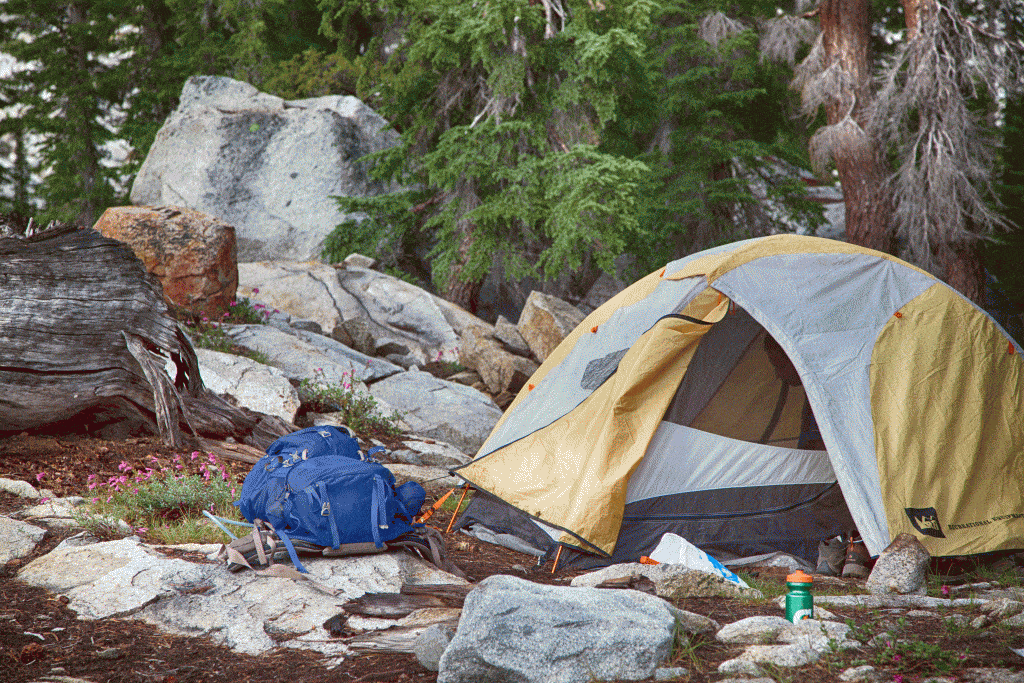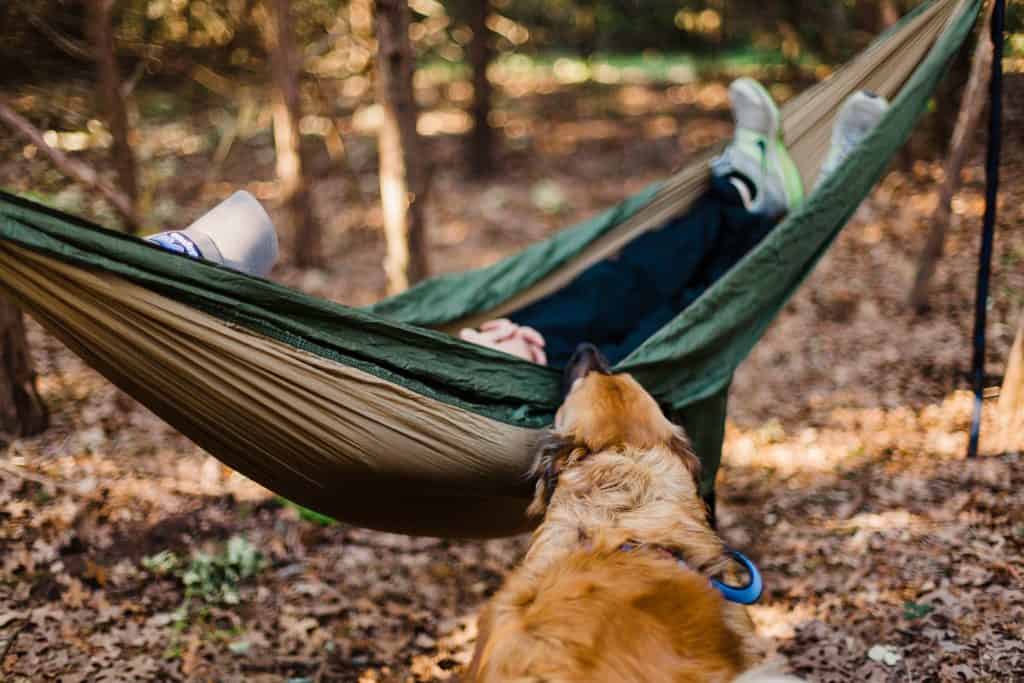Camping with your furry friends can be a memorable adventure, but it requires some extra planning and considerations to ensure a safe and enjoyable experience. In this comprehensive guide, we’ll cover essential tips and tricks for camping with pets. From choosing the right campsite to packing the perfect pet-friendly gear, we’ve got you covered.
1. Selecting the Ideal Campsite
Choosing the right campsite when camping with your beloved pets is a critical first step to ensure a safe and enjoyable outdoor experience for both you and your furry companions. Here are some essential factors to consider when selecting the ideal campsite for camping with pets:
National Park campsite reservations can be done here.

1. **Pet-Friendly Campgrounds:**
– Start your search by looking for campgrounds that are explicitly labeled as “pet-friendly.” These campgrounds are more likely to have amenities and rules in place to accommodate pets.
2. **Regulations and Rules:**
– Read the campsite’s regulations regarding pets. Pay attention to rules about leash requirements, designated pet areas, and quiet hours. Make sure you’re comfortable with these regulations.
3. **Amenities:**
– Look for campgrounds that offer amenities for pets, such as dog parks, pet-washing stations, or nearby pet-friendly trails. These extras can enhance your pet’s camping experience.
4. **Trail Access:**
– If you plan to explore hiking trails, check if the campsite has pet-friendly trails nearby. Confirm that these trails allow pets and if they have any specific restrictions.
5. **Proximity to Water:**
– Ensure that the campsite has access to clean water sources. Pets, like humans, need hydration, and it’s essential to have water readily available.
6. **Campsite Layout:**
– Choose a campsite with a layout that accommodates pets. Look for a site with enough space for your pet to move around safely. Avoid cramped sites or those near high-traffic areas.
7. **Pet-Proofing:**
– Inspect the campsite for potential hazards like sharp rocks, thorny plants, or toxic substances. Make sure the site is safe for your pet.
8. **Nearby Wildlife:**
– Consider the presence of wildlife in the area. Some animals might be curious about your pet or vice versa. Be cautious and keep your pet under control.
9. **Quiet Environment:**
– Ensure the campsite offers a peaceful environment where your pet can relax. A quiet campsite minimizes stress for both you and your pet.
10. **Shade and Shelter:**
– Look for shaded areas or access to shelter. Pets need protection from the sun and elements, just like humans.
11. **Neighbors:**
– If possible, chat with neighboring campers to confirm their comfort level with pets. Good communication can prevent any potential conflicts.
12. **Pet Waste Disposal:**
– Verify that the campsite has designated areas for pet waste disposal and that you have the necessary supplies to clean up after your pet.
13. **Distance from Other Campers:**
– Choose a campsite that provides some distance from other campers. This way, your pet’s occasional barking or excitement won’t disturb neighboring campers.
14. **Pet Comfort:**
– Create a comfortable and secure space within your campsite for your pet. Bring their bed, blankets, or familiar items to make them feel at home.
15. **Emergency Services:**
– Know the location of the nearest veterinarian or emergency pet services. Be prepared for any unexpected health issues.
When selecting the ideal campsite for camping with pets, thorough research and careful consideration are key. By choosing a pet-friendly campground that aligns with your pet’s needs and your camping preferences, you can ensure a safe and enjoyable outdoor adventure for all members of your camping party.
2. Preparation and Packing
Camping with your four-legged companions can be a wonderful experience, but it requires careful preparation and packing to ensure the safety, comfort, and enjoyment of both you and your pets. Here’s a comprehensive guide on how to prepare and what to pack for a camping trip with your furry friends:
**1. Research and Planning:**
– Start by researching the campsite and the area you plan to visit. Ensure the campsite is pet-friendly and offers the amenities you and your pets need.
**2. Health Check:**
– Visit your veterinarian for a check-up before your trip. Ensure your pets are up to date on vaccinations, and discuss any specific concerns related to the camping environment.
**3. ID Tags and Microchips:**
– Make sure your pets have proper identification tags with your contact information. Consider getting them microchipped for an added layer of security.
**4. Leash and Collar:**
– Pack a sturdy leash and collar for each pet. Opt for a leash that’s suitable for the environment, whether it’s a retractable leash for open spaces or a shorter one for crowded areas.
**5. Harness:**
– A harness can provide more control over your pet, especially if they tend to pull on the leash. Ensure it’s comfortable and properly fitted.
**6. Travel Crate or Carrier:**
– If you’re bringing a smaller pet, consider a travel crate or carrier for their safety during transportation and as a secure space at the campsite.
**7. First Aid Kit for Pets:**
– Assemble a first aid kit specifically for your pets. Include items like bandages, antiseptic wipes, tweezers, and any prescribed medications.
**8. Pet-Friendly Camping Gear:**
– Invest in pet-specific camping gear, such as a portable water bowl, pet-sized sleeping bag, and a camping-friendly pet tent.
**9. Food and Water:**
– Pack enough pet food for the duration of your trip, plus extra in case of unexpected delays. Bring your pet’s regular food to avoid digestive issues.
**10. Food and Water Bowls:**
– Collapsible, lightweight food and water bowls are ideal for camping. They’re easy to pack and clean.
**11. Medications:**
– Ensure you have an adequate supply of any medications your pets are taking. Keep them in a waterproof container.
**12. Health Records:**
– Carry copies of your pets’ health records, including vaccination records, in case they’re needed during the trip.
**13. Bedding and Comfort:**
– Bring your pet’s bed, blanket, or a familiar item to provide them with comfort and security at the campsite.
**14. Poop Bags:**
– Pack plenty of biodegradable poop bags for waste cleanup. Leave no trace, and always clean up after your pets.
**15. Toys and Entertainment:**
– Keep your pets entertained with their favorite toys. Familiar items can reduce stress and boredom.
**16. Tick and Flea Prevention:**
– Apply tick and flea prevention products before your trip. Continue protection during the camping trip, as these pests can be prevalent in outdoor environments.
**17. Portable Fencing:**
– If you have a pet that roams freely, consider portable pet fencing to create a safe play area at the campsite.
**18. Pet Wipes:**
– Pet wipes are handy for cleaning muddy paws or freshening up your pet between baths.
**19. Emergency Contacts:**
– Have contact information for local veterinarians and emergency pet services in the area you’re camping.
**20. Enjoy the Journey:**
– Keep your pets safe and secure during travel, whether they’re in a crate, harnessed, or in the back seat of the car.
**21. Responsible Disposal:**
– Dispose of pet waste responsibly in designated areas. Never leave waste behind.
**22. Enjoy the Experience:**
– Embrace the adventure and cherish the moments with your pets. Camping with them is a unique and rewarding experience.
By being well-prepared and ensuring your pets have everything they need for a safe and comfortable camping trip, you can create unforgettable memories and strengthen the bond between you and your furry companions.
3. Pet-Proofing Your Camp
When camping with your beloved pets, ensuring their safety and well-being is of utmost importance. One key aspect of pet safety is pet-proofing your campsite. Here are some essential steps to make your camping area secure and enjoyable for your four-legged friends:

**1. Inspect the Campsite:**
– Upon arrival, thoroughly inspect the campsite for any potential hazards that could harm your pets. Look for sharp objects, toxic plants, or any other dangers.
**2. Clear the Campsite:**
– Remove debris, sticks, and rocks from the campsite area to prevent your pets from stepping on or ingesting them.
**3. Secure the Tent Area:**
– If your pets are sleeping in the tent, ensure that the area is safe and comfortable for them. Remove any objects that could be chewed or knocked over.
**4. Choose a Safe Campfire Area:**
– Keep your pets away from the campfire area to prevent burns or accidental contact with hot embers.
**5. Set Up Pet-Friendly Boundaries:**
– Establish boundaries using leashes or portable pet fences to confine your pets to a safe area within the campsite.
**6. Keep Food Secure:**
– Store all food, including pet food, in a secure container or cooler to prevent your pets from accessing it, which can lead to stomach issues or attracting wildlife.
**7. Check Tent Zippers:**
– Inspect the tent zippers and ensure they are closed properly to prevent your pets from escaping during the night.
**8. Pet-Proof Tent and Gear:**
– Use pet-friendly gear, such as a pet tent or sleeping bag, to provide a comfortable space for your pets. Make sure it’s free of hazards and suitable for their needs.
**9. Eliminate Trip Hazards:**
– Avoid leaving items lying around that could pose tripping hazards for you and your pets.
**10. Maintain a Clean Campsite:**
– Regularly clean the campsite to remove pet waste and any potential attractants for wildlife.
**11. Prevent Digging:**
– If your pets are prone to digging, discourage this behavior by supervising them and providing designated areas for digging.
**12. Supervise Off-Leash Time:**
– Allow your pets off-leash only in safe, designated areas. Always supervise their activities to prevent them from running off or getting into trouble.
**13. Use Pet-Safe Insect Repellent:**
– Protect your pets from insects by using pet-safe repellents or insect control products, as recommended by your veterinarian.
**14. Keep an Eye on Wildlife:**
– Be vigilant about wildlife in the area. Keep your pets at a safe distance to prevent any confrontations.
**15. Maintain Hydration:**
– Ensure your pets have access to clean water at all times. Dehydration can be a risk, especially in hot weather.
**16. Provide Comfort:**
– Create a cozy spot for your pets to relax within the campsite. Bring their bed or blanket for added comfort.
**17. Stay Aware of Temperature:**
– Be mindful of temperature extremes. Protect your pets from both heat and cold by providing adequate shelter and hydration.
**18. Follow Campsite Rules:**
– Respect campsite rules and guidelines regarding pets, including leash requirements and designated pet areas.
By pet-proofing your campsite and being attentive to your pets’ needs, you can ensure a safe and enjoyable camping experience for both you and your furry companions. Campsites that are secure and hazard-free provide peace of mind and allow you to focus on making wonderful memories together in the great outdoors.
4. Keeping Your Pet Safe
Camping with your pets is a delightful experience, but ensuring their safety is a top priority. The great outdoors can present various challenges, so it’s essential to take precautions and keep your pets safe during your camping adventure. Here are some important tips to help you achieve this:

**1. Supervision:**
– Always keep a close eye on your pets. Whether they’re exploring the campsite, playing, or resting, your watchful presence can prevent accidents.
**2. Leash Use:**
– Use a leash, especially in unfamiliar or crowded areas. This keeps your pets from wandering too far and encountering potential dangers.
**3. Recall Training:**
– Teach your pets basic recall commands like “come” or “stay” before your trip. These commands can help you maintain control when off-leash.
**4. Safe Tent Entry:**
– Be cautious when entering and exiting your tent. Ensure your pets don’t dart out or get caught in tent zippers.
**5. Secure the Campfire:**
– Pets are naturally curious about campfires. Keep them a safe distance away to avoid burns or embers.
**6. Wildlife Awareness:**
– Be aware of the presence of wildlife in the area. Keep your pets away from potentially dangerous encounters.
**7. Pet-Proof the Campsite:**
– Remove potential hazards such as sharp objects or toxic plants from the campsite to prevent injuries.
**8. Keep Pets Hydrated:**
– Ensure your pets have access to clean water at all times. Dehydration can be a risk, especially in hot weather.
**9. Pet-Friendly Sun Protection:**
– Protect your pets from the sun’s rays by providing shade, using pet-safe sunscreen, or using clothing designed for sun protection.
**10. Tick and Flea Checks:**
– After hikes or outdoor activities, inspect your pets for ticks, fleas, or other pests. Prompt removal is essential.
**11. Safe Exploration:**
– When letting your pets explore off-leash, choose safe areas where they can roam freely without encountering hazards or wildlife.
**12. Camping Gear for Pets:**
– Use pet-specific camping gear, such as a portable pet tent, to provide a safe and comfortable space for your pets at the campsite.
**13. Pet ID and Microchipping:**
– Ensure your pets have proper identification with ID tags and consider microchipping them in case they get lost.
**14. Campsite Etiquette:**
– Respect fellow campers by maintaining campsite etiquette. Keep your pets from disturbing other campers with excessive barking or running through their campsites.
**15. Secure Food and Trash:**
– Store all food in secure containers to prevent your pets from accessing it, which can lead to stomach issues or attracting wildlife. Dispose of trash properly.
**16. Emergency Services:**
– Know the location of the nearest veterinarian or emergency pet services in the camping area. Be prepared for any unexpected health issues.
**17. Weather Considerations:**
– Be mindful of weather conditions. Protect your pets from both heat and cold by providing shelter and hydration as needed.
Camping with pets can be a wonderful bonding experience. By taking these precautions and being proactive about their safety, you can ensure a memorable and safe adventure in the great outdoors. Your pets will appreciate your care and enjoy the outdoor journey as much as you do.
5. Enjoying Outdoor Activities
Engage your pet in fun outdoor activities like fetch or swimming to keep them active and happy.
6. Pet-Friendly Hiking Tips
Follow Leave No Trace principles by keeping your pet on designated trails. Check for ticks and debris in your pet’s fur after hikes.
7. Feeding and Hydration
Stick to your pet’s regular diet to avoid upset stomachs. Bring clean water and a portable bowl to keep your pet hydrated.
8. Responsible Waste Management
Dispose of pet waste in designated areas. Use biodegradable bags and always clean up after your pet.
9. Sleeping Arrangements
Create a cozy sleeping spot for your pet inside the tent. Ensure they are comfortable and warm.
10. Pet Health and First Aid
Know the location of the nearest vet and carry a pet-specific first aid kit. Watch for signs of illness or injury.
11. Wildlife Awareness
Be vigilant about wildlife in the area. Keep your pet away from potentially dangerous encounters.
12. Campfire Safety
Teach your pet to stay away from the campfire. Keep them safe from burns and sparks.
13. Leash Etiquette
Respect fellow campers by keeping your pet on a leash when required. Maintain good campsite etiquette.
14. Stress Management
Understand that camping can be overwhelming for pets. Offer comfort and familiarity to reduce stress.
Camping with pets is a bonding experience like no other. Embrace the challenges, relish the moments, and make unforgettable memories with your loyal companion.
**5 Unique FAQs**
**Q1. Can I camp with any type of pet?**
Camping with pets is typically suitable for dogs, but you can camp with other pets like cats or small animals as long as the campground allows it and you take their needs into account.
**Q2. How can I keep my pet warm in cold weather?**
Pack pet-specific cold-weather gear like insulated coats and cozy blankets. Make sure your pet sleeps inside the tent for added warmth.
**Q3. Are there pet-friendly campgrounds that offer amenities for pets?**
Yes, some campgrounds have dedicated dog parks, pet-washing stations, and even pet-sitting services. Research and choose a pet-friendly site with amenities that suit your needs.
**Q4. Can I take my pet on a backcountry camping trip?**
Backcountry camping with pets requires careful planning and consideration. Ensure your pet can handle the terrain and that you have the necessary gear to keep them safe.
**Q5. How can I prevent my pet from disturbing other campers?**
Training is key. Teach your pet basic obedience commands and practice good leash etiquette to ensure a harmonious camping experience for everyone.
In conclusion, camping with pets can be a rewarding and fulfilling adventure. With the right preparations and a focus on your pet’s safety and well-being, you can create lasting memories in the great outdoors while enjoying the companionship of your furry friend.
Camping Tips:
Delicious Campfire Recipes – Feast Under the Stars
Campfire Cooking Tips – Everything You Need to Know !
How to Choose the Right Tent for Camping
Camping Hacks for Beginners: Expert Tips !
Your Ultimate Checklist for Camping: Fail Proof List !
Best Campsite Recommendations
Top 10 Camping Destinations in Southern California
Top 10 Camping Destinations in Northern California
20 Must-Visit National Forest Campgrounds in California
California’s Finest: The Top 20 Campsites in State Parks
